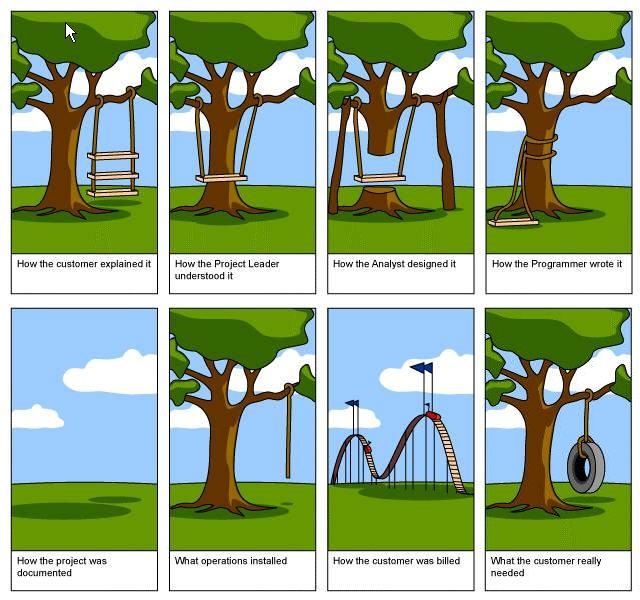by Saeed Khan
This is part 3 of this series on problems in Product Management today.
Part 1 of this series covered issues with various Product Management roles and responsibilities. Part 2 discussed the problems with repeatable processes for to define and launch new products.
This post focuses on problems in intra- and extra-company communication and alignment. So what does this really mean?
Virtually everyone has seen the famous swingset graphic. It’s the iconic metaphor describing common communication problems in companies.
It may seem unnecessary to remind ourselves that we are all information workers, but that fact lies at the foundation of this problem.
Information: how we create it, store it, convey it, interpret it, and use it, lies at the heart of product success. ![]() Even if we have the roles (part 1) and processes (part 2) defined correctly, what connects them together is an effective communication process across all necessary groups, both internal and external to the company.
Even if we have the roles (part 1) and processes (part 2) defined correctly, what connects them together is an effective communication process across all necessary groups, both internal and external to the company.
Are people making the best decisions they can?
Everyone needs information to make informed decisions. If they have it when they need it, the decisions will be both timely and informed. If they don’t have the information, those decisions will be poor or delayed.
How often have you had people ask questions like the following:
- When will the next version of [Product X] be released? What will be in it?
- I have a customer interested in [Product X]. Does it support any of the following use cases?
- Where can I find the latest competitive information we have against [Competitor A]?
- Can someone help me understand how this CPU core-based licensing works for a virtual environment?
- Do we have any reference accounts for [Product Y]. I need one in Latin America in Manufacturing.
- I’m in the late stages of an opportunity. How do I show the ROI of [Product Z] to a prospect? Where can I find that information?
- Etc. Etc. Etc.
- I’m doing customer cross-sell analysis. Where can I find sales information for EMEA for the last 2 years for products [A,B,C,D,E]?
There’s no limit to the potential questions. And they can come from all parties, internal or external. And the more people have to hunt and search for this information, the more problematic.
Focus and understanding are related and proportional
Consider the following. As a product manager, you spend most, if not all of your time thinking about your product, how to make it more successful, how to bring it to market, what market and customer needs it addresses, how to compete against competitors, how to position it’s features and benefits, the overall value it delivers etc. You go to work everyday thinking about these things.
Now think about marketers or sales reps in your company. They are not focused on your product the way you are. They look the world differently, with different goals and objectives, with different levels of depth and clarity. They are dependent on others (you? the product team?) to provide them with key information in order to do their jobs.
Now think about partners and customers — people external to your company. They have even less information and knowledge than your marketers or sales reps. And they certainly don’t think about or care about your product the way anyone in your company does, because they have their own goals and objectives, and yet they depend on your marketers and sales reps (and others) to arm them with the information they need.
And who depends on them for information? It’s a real-life version of the telephone game.
Does this sound familiar? Have you experienced it in any company you’ve worked in? How have you addressed it or tried to address it? And no, Sharepoint is not the answer. 🙂
Saeed
Tweet this: The 3 biggest problems in Product Management today – part 3 – Communication http://wp.me/pXBON-43Q #prodmgmt
 Saeed Khan is a founder and Managing Editor of On Product Management, and has worked for the last 20 years in high-technology companies building and managing market leading products. He also speaks regularly at events on the topic of product management and product leadership. You can contact him via Twitter @saeedwkhan or via the Contact Us page on this blog.
Saeed Khan is a founder and Managing Editor of On Product Management, and has worked for the last 20 years in high-technology companies building and managing market leading products. He also speaks regularly at events on the topic of product management and product leadership. You can contact him via Twitter @saeedwkhan or via the Contact Us page on this blog.
